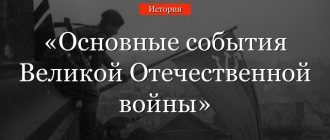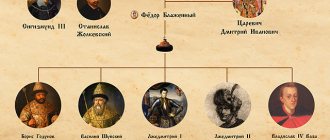Presentation “Battle for Moscow”
#Secondary vocational education #Project activity #Presentation #Victory Day #May 9
(1941-1942)
We are preparing to celebrate the 75th anniversary of the Battle of Moscow. The most important event of the first year of the Great Patriotic War was the historical battle of Moscow from September 30, 1941 to January 1942. Hitler's command placed a special emphasis on capturing the capital of our Motherland. The main forces of the Nazi army were concentrated on the approaches to Moscow. However, the enemy's superiority in both manpower and equipment did not break the fighting spirit of the capital's defenders.
Preceding Events: The original plan for the blitzkrieg (Operation Barbarossa) envisaged the capture of Moscow within the first three or four months of the war. However, despite the successes of the Wehrmacht in the first months of the war, increased resistance from Soviet troops prevented its implementation. In particular, the Battle of Smolensk (July 10 - September 10, 1941) delayed the German offensive on Moscow for 2 months. The battles for Leningrad and Kyiv also delayed part of the Wehrmacht forces intended for the attack on Moscow. Thus, the German offensive on Moscow began only on September 30. The goal of the operation was to capture Moscow before the onset of cold weather.
Plans of the parties: On September 6, 1941, the Commander-in-Chief of the Wehrmacht A. Hitler, in his Directive No. 35, ordered the defeat of Soviet troops in the Moscow direction before the onset of winter. On September 16, as the battle for Kyiv was nearing its end, the command of Army Group Center issued a directive to prepare an operation to capture Moscow, codenamed “Typhoon.” The idea of the operation was to use powerful strikes from large groups concentrated in the areas of Dukhovshchina (3rd Tank Group), Roslavl (4th Tank Group) and Shostka (2nd Tank Group) to encircle the main forces of the Red Army troops covering the capital and destroy them in the areas of Bryansk and Vyazma, and then quickly bypass Moscow from the north and south with the aim of capturing it. A. Hitler
Defense of Moscow (Operation Typhoon) On September 30, with the transition of the 2nd Tank Group to the offensive, the German command began to implement Operation Typhoon. On October 2, the main forces of Army Group Center went on the offensive in the Moscow direction. During the Moscow defensive operation, the following were carried out: Oryol-Bryansk, Vyazemsk, Kalinin, Tula, Klin-Solnechnogorsk and Naro-Fominsk frontal defensive operations.
The defeat of the Bryansk Front: October 1, the VKG Headquarters decides to form the 1st Guards Rifle Corps from the reserve for the defense of Orel, however, due to the rapid advance of Guderian’s troops, at the proposal of the appointed corps commander, Major General D.D. Lelyushenko decided to organize the defense to the north. On October 2, the 1st Guards Rifle Corps, supported by the 6th Reserve Air Group of the Headquarters and front-line aviation, moved towards Mtsensk. Guderian's 2nd Panzer Group immediately achieved serious success. Already on October 3, units of the 24th Motorized Corps broke into Oryol, 200 km from the offensive line. When the German 4th Panzer Division burst into the city, trams were still running through the streets and boxes of unevacuated factory equipment were lying around. On the evening of October 3, the 4th Tank Brigade of Colonel M.E. arrived in Mtsensk. Katukova. On October 4, on the outskirts of Mtsensk, the Soviet 4th Tank Brigade, with the support of Captain Chumak's guards mortar division, attacked the marching columns of the German 4th Tank Division and actually put it out of action. The battles for Mtsensk pinned down German troops for a week. On the evening of October 5, the Bryansk Front was allowed to withdraw troops to the second line of defense in the Bryanskaya area at the line of the river. Gum. However, already on October 6, the German 17th Panzer Division captured Bryansk, and the 18th Panzer Division captured Karachev, thus cutting off the forces of the Bryansk Front. Front commander A. I. Eremenko was forced to give the order to the front armies to fight “with an inverted front.” The forces of the 3rd, 13th and 15th Soviet armies were encircled near Bryansk: 27 divisions, 2 tank brigades, 19 artillery regiments of the RGK and the command and control of the 50th, 3rd and 13th armies of the Bryansk Front. During the escape from the encirclement, the commander of the 50th Army, Major General M.P. Petrov, died. While trying to escape the encirclement on October 13, Eremenko himself was seriously wounded and was evacuated to Moscow by a plane specially sent for him.
Vyazemsky “cauldron”: On October 2, the offensive of the remaining forces of Army Group Center began. Having created an overwhelming advantage in narrow areas, German troops broke through the front of the Soviet defense. On October 4, Spas-Demensk and Kirov were captured, and on October 5, Yukhnov. On the same day, the enemy entered the Vyazma area. For a flank counterattack against the advancing group, the front group of I.V. Boldin was created. However, as a result of a tank battle in the area south of Kholm-Zhirkovsky, Soviet troops were defeated. On October 7, the German 7th Panzer Division of the 3rd Panzer Group and the 10th Panzer Division of the 4th Panzer Group closed the encirclement of the troops of the Western and Reserve Fronts in the Vyazma region. 37 divisions, 9 tank brigades, 31 artillery regiments of the RGK and the commands of the 19th, 20th, 24th and 32nd armies were surrounded (the command of the 16th Army, having transferred the troops to the 19th Army, managed to get out of the encirclement ). Until October 11, the encircled troops attempted to break through; only on October 12 did they manage to briefly make a hole, which was soon closed again. In total, more than 688 thousand Soviet soldiers and officers were captured near Vyazma and Bryansk; only about 85 thousand managed to escape from encirclement. In the Vyazma “cauldron”, the commander of the 19th Army, Lieutenant General M.F. Lukin, and the commander of the 32nd Army were captured. 1st Army Major General S.V. Vishnevsky, commander of the 24th Army Major General K.I. Rakutin died. Rakutin K.I.
Mozhaisk line of defense: The unfavorable development of military operations in the area of Vyazma and Bryansk created a great danger for Moscow. In order to unite the leadership of the troops in the western direction, the remaining troops of the Reserve Front were transferred on October 10 to the Western Front, whose commander on that day was Army General G. K. Zhukov (I. S. Konev was left as his deputy). On October 12, the troops of the Mozhaisk defense line were subordinated to the Western Front. However, the position of the troops of the Western Front, who took up defensive positions on the Mozhaisk Line, remained extremely difficult. On the front from the Moscow Sea to Kaluga, the Western Front consisted of only about 90 thousand people. Under these conditions, the front command sought to firmly cover only the most important directions leading to Moscow: Volokolamsk, Mozhaisk, Maloyaroslavets and Kaluga. On October 19, part of the troops of the 43rd Army in the Verei direction were subordinated to the headquarters of the 33rd Army (brigade commander D.N. Onuprienko, since October 25, Lieutenant General M.G. Efremov). Already on October 13, Kaluga fell, on October 16 - Borovsk, on October 18 - Mozhaisk and Maloyaroslavets. Only with the greatest effort was it possible to stop the enemy at the border of the Protva and Nara rivers. Zhukov G.K.
On October 16, the Wehrmacht's general offensive began in the Volokolamsk direction. Here the 316th Infantry Division of Major General I.V. Panfilov especially distinguished itself. One of the lines of defense of the capital passed at the Dubosekovo railway crossing. He found himself in the direction of the main attack of the Nazis. The Nazis hoped to break through our defenses in this area, break out onto the Volokolamsk Highway and move towards Moscow. Here, on November 16, a group of tank destroyers of the 1075th Infantry Regiment of the 316th Infantry Division of General I.V. Panfilov accomplished their immortal feat. 28 heroes took on the blow of 50 enemy tanks. On October 16, the Wehrmacht's general offensive began in the Volokolamsk direction. Here the 316th Infantry Division of Major General I.V. Panfilov especially distinguished itself. One of the lines of defense of the capital passed at the Dubosekovo railway crossing. He found himself in the direction of the main attack of the Nazis. The Nazis hoped to break through our defenses in this area, break out onto the Volokolamsk Highway and move towards Moscow. Here, on November 16, a group of tank destroyers of the 1075th Infantry Regiment of the 316th Infantry Division of General I.V. Panfilov accomplished their immortal feat. 28 heroes took on the blow of 50 enemy tanks.
On October 19, part of the troops of the 43rd Army in the Verei direction were subordinated to the headquarters of the 33rd Army (brigade commander D.N. Onuprienko, since October 25, Lieutenant General M.G. Efremov). Already on October 13, Kaluga fell, on October 16 - Borovsk, on October 18 - Mozhaisk and Maloyaroslavets. Only with the greatest effort was it possible to stop the enemy at the border of the Protva and Nara rivers. Despite the stubborn resistance of the Soviet troops, by the end of October 1941, German troops of the 4th Army and 4th Tank Group managed to knock down the Western Front formations from the Mozhaisk defense line along almost its entire length and gradually push them towards Moscow. The fighting on the Mozhaisk defense line lasted an average of 7-9 days, and in the Volokolamsk direction 10-12 days. Although the Soviet troops lost their support in the form of engineering structures, time was spent breaking the defense line, which the Red Army command used to consolidate the battle formations of the troops defending the capital. Thus, it was not possible to stabilize the defenses on the distant approaches to Moscow, and fighting at the end of October was already taking place 80-100 km from Moscow. On October 19, part of the troops of the 43rd Army in the Verei direction were subordinated to the headquarters of the 33rd Army (brigade commander D.N. Onuprienko, since October 25, Lieutenant General M.G. Efremov). Already on October 13, Kaluga fell, on October 16 - Borovsk, on October 18 - Mozhaisk and Maloyaroslavets. Only with the greatest effort was it possible to stop the enemy at the border of the Protva and Nara rivers. Despite the stubborn resistance of the Soviet troops, by the end of October 1941, German troops of the 4th Army and 4th Tank Group managed to knock down the Western Front formations from the Mozhaisk defense line along almost its entire length and gradually push them towards Moscow. The fighting on the Mozhaisk defense line lasted an average of 7-9 days, and in the Volokolamsk direction 10-12 days. Although the Soviet troops lost their support in the form of engineering structures, time was spent breaking the defense line, which the Red Army command used to consolidate the battle formations of the troops defending the capital. Thus, it was not possible to stabilize the defenses on the distant approaches to Moscow, and fighting at the end of October was already taking place 80-100 km from Moscow.
Kalinin defensive operation: Meanwhile, the German 3rd Panzer Group turned towards Kalinin and took the city on October 14th. The main objective of this turn was to create a new “cauldron” with the forces of the 9th Army and the 3rd Tank Group on the northern flank of Army Group Center. To cover the capital from the north-west, on October 17, on the basis of the troops of the right wing of the Western Front (22nd, 29th, 31st and 30th armies), the Kalinin Front (Colonel General I.S. Konev) was created. Front troops, supported by aviation, attacked the Germans daily in the Kalinin area. As a result of these actions, on October 23, von Bock issued a directive to suspend the offensive through Kalinin. Thus, energetic attacks in the Kalinin area, although they did not lead to the capture of the city, did disrupt the completion of the main task, for which the 3rd Panzer Group was deployed from Moscow to the north. I.S.Konev
The final push on Moscow: To resume the offensive on Moscow, the Wehrmacht deployed 51 divisions, including 13 tank and 7 motorized. According to the plan of the German command, Army Group Center was supposed to defeat the flank defense units of the Soviet troops and encircle Moscow. The Soviet command reinforced dangerous sectors of the front with reserves and reinforcements. The parade on November 7, 1941 on Red Square was of great political significance. Thus, the government of the USSR and J.V. Stalin personally demonstrated their determination to fight to the end. The German offensive against Moscow resumed from the northwest on November 15-16, and from the southwest on November 18. The enemy delivered the main attacks in the Klin-Rogachevo and Tula-Kashira directions. At the end of November, the enemy managed to capture the Klin, Solnechnogorsk, Istra areas, reach the Moscow-Volga canal in the Yakhroma area and occupy Krasnaya Polyana (27 km from Moscow). Further advance of the Germans in the northern direction was prevented by the release of water from the Istrinsky, Ivankovsky reservoirs and reservoirs of the Moscow Canal.
“...As the Germans approached this line, the spillways of the reservoir were blown up (at the end of the crossing of our troops), as a result of which a water flow up to 2.5 m high was formed over a distance of up to 50 km south of the reservoir. The Germans’ attempts to close the spillways were unsuccessful.” Marshal Shaposhnikov
The 1st Shock Army and the 20th Army were transferred to the Western Front, which covered the gap between the 30th (transferred to the Western Front on November 17) and the 16th armies. As a result of the involvement of Soviet reserves, the enemy was stopped and forced to go on the defensive. At the end of November there were fierce battles in the area of Kashira and Tula. On November 27, Soviet troops launched a counterattack on the 2nd Tank Army and drove it back from Kashira. The 2nd Tank Army tried to bypass Tula from the northeast and cut the Serpukhov-Tula railways and highways, but a counterattack by the Soviet troops drove the enemy back to their original positions. On December 1, the command of Army Group Center made a new attempt to break through to Moscow in the Aprelevka area, but it also ended in failure. The Supreme High Command Headquarters ordered, in addition to the new 10th and 20th armies transferred to the Western Front from the reserve of the 1st Shock Headquarters, to include the 24th and 60th armies in the Moscow defense zone. On December 2, the advanced units of the 1st Shock and 20th armies repelled all enemy attacks north of Moscow in the Dmitrov area and to the south and forced him to stop the offensive. On December 3-5, the 1st Shock and 20th Armies launched several strong counterattacks in the area of Yakhroma and Krasnaya Polyana and began to push back the enemy. The left-flank divisions of the 16th Army, in cooperation with the 5th Army, drove the enemy back from the large bend of the river. Moscow northeast of Zvenigorod. The strike group of the 33rd Army, having defeated enemy units on December 4-5, restored the situation on the river. Nara. The 1st Shock Army and the 20th Army were transferred to the Western Front, which covered the gap between the 30th (transferred to the Western Front on November 17) and the 16th armies. As a result of the involvement of Soviet reserves, the enemy was stopped and forced to go on the defensive. At the end of November there were fierce battles in the area of Kashira and Tula. On November 27, Soviet troops launched a counterattack on the 2nd Tank Army and drove it back from Kashira. The 2nd Tank Army tried to bypass Tula from the northeast and cut the Serpukhov-Tula railways and highways, but a counterattack by the Soviet troops drove the enemy back to their original positions. On December 1, the command of Army Group Center made a new attempt to break through to Moscow in the Aprelevka area, but it also ended in failure. The Supreme High Command Headquarters ordered, in addition to the new 10th and 20th armies transferred to the Western Front from the reserve of the 1st Shock Headquarters, to include the 24th and 60th armies in the Moscow defense zone. On December 2, the advanced units of the 1st Shock and 20th armies repelled all enemy attacks north of Moscow in the Dmitrov area and to the south and forced him to stop the offensive. On December 3-5, the 1st Shock and 20th Armies launched several strong counterattacks in the area of Yakhroma and Krasnaya Polyana and began to push back the enemy. The left-flank divisions of the 16th Army, in cooperation with the 5th Army, drove the enemy back from the large bend of the river. Moscow northeast of Zvenigorod. The strike group of the 33rd Army, having defeated enemy units on December 4-5, restored the situation on the river. Nara.
Results of the defense of Moscow: During the defensive stage of the Battle of Moscow, the Soviet command imposed a “war of attrition” on the enemy (when the “last battalion” rushes into battle, which must decide the outcome of the battle). But if during the battle all the reserves of the German command were exhausted, the Soviet command was able to preserve the main forces (of the strategic reserves, only the 1st Shock Army and the 20th Army were brought into battle). “The attack on Moscow failed. All the sacrifices and efforts of our valiant troops were in vain. We suffered a serious defeat, which, due to the stubbornness of the high command, led to fatal consequences in the coming weeks. During the German offensive, a crisis arose, the strength and morale of the German army were broken” G. Guderian
Soviet counteroffensive near Moscow: on December 5, troops of the Kalinin Front (Colonel General I. S. Konev), and on December 6 - the Western (Army General G. K. Zhukov) and the right wing of the Southwestern Front (Marshal S. K. Timoshenko) launched a counteroffensive. By the beginning of the counteroffensive, Soviet troops numbered more than 1 million soldiers and officers. On December 8, the Commander-in-Chief of the Wehrmacht A. Hitler signed Directive No. 39 on the transition to defense on the entire Soviet-German front. During the Soviet counteroffensive near Moscow, the Kalinin, Klin-Solnechnogorsk, Narofominsk-Borovsk, Eletsk, Tula, Kaluga and Belevsko-Kozel offensive operations were carried out.
Kalinin offensive operation: At the beginning of December 1941, an attack force consisting of five rifle divisions of the 31st Army and three rifle divisions of the 29th Army was concentrated in the Kalinin area. These armies did not receive newly formed divisions and fought with formations that had been thinned out in the battles for Moscow. The formations of the left flank of the 29th Army under Lieutenant General I. I. Maslennikov (from December 12 - Major General V. I. Shvetsov) went on the offensive on December 5, but were unable to break through the defenses of the infantry divisions of the 9 Army. The troops of the 31st Army of Major General V.A. Yushkevich, after stubborn three-day battles, broke through the enemy defenses, by the end of December 9 they advanced 15 km and created a threat to the rear of the enemy group in the Kalinin area. At the same time, the offensive launched by the 30th Army of the Western Front threatened to reach the rear of the German 9th Army in the Kalinin direction. On the night of December 16, the command of the 9th Army ordered a retreat from the Kalinin area. On the morning of December 16, the troops of the 31st and 29th armies resumed their offensive. The city was taken on December 16. In the twentieth of December, a fresh 39th Army (Lieutenant General I.I. Maslennikov) was introduced into the junction of the 22nd and 29th armies. By the end of December, the troops of the Kalinin Front in the zone of the 39th Army broke through the enemy’s defenses to the entire tactical depth. During the battles of January 2-7, 1942, front troops on the right wing reached the river line. Volga, in the center they broke through a new line of defense organized by the enemy along the right bank of the Volga, and captured Rzhev from the west and southwest.
Klin-Solnechnogorsk offensive operation: The idea of the operation was to cut through the main forces of the German 3rd and 4th tank groups in areas of Klin, Istra, Solnechnogorsk and create favorable conditions for the further development of the offensive to the west. The troops of the 30th Army (Major General D. D. Lelyushenko), which began the offensive on December 6, broke through the front of two enemy motorized divisions defending against them. By the end of the day on December 7, they had advanced 25 km. The 1st Shock Army (Lieutenant General V.I. Kuznetsov) concentrated its main efforts on the right flank and in the center, in the Yakhroma area. The most difficult was the transition to the counteroffensive of the 20th (Major General A. A. Vlasov) and 16th armies (Lieutenant General K. K. Rokossovsky). Only on December 9 did the German troops opposing the 16th Army begin to withdraw in the northwestern and western directions. The main battles on the right wing of the Western Front took place around Klin. By the evening of December 13, the Klin enemy group found itself semi-surrounded. On the night of December 15, units of the 30th Army entered Klin. After the end of the fighting on December 16, 1941, the 30th Army was transferred to the Kalinin Front. At this time, the 16th and 20th armies were moving west. At the turn of the Istrinsky reservoir, German troops tried to provide serious and long-term resistance to our troops. The water from the reservoir was drained, the ice dropped several meters and was covered with a layer of water of 35-40 cm near the western shore. However, on December 15, the exit of two Soviet flank groups north and south of the reservoir forced the German command to quickly retreat westward. Thus, the enemy’s defenses at the line of the Istra Reservoir were broken through. In the second ten days of December, the 5th Army (Lieutenant General L.A. Govorov) joined the offensive of the right wing of the Western Front. She ensured the entry into battle of the 2nd Guards Cavalry Corps of Major General L. M. Dovator. On December 20, German troops were driven out of Volokolamsk. On the same day, the right-flank units of the 1st Shock Army, pursuing the enemy, reached the river. Lame. The attempt of the 1st Shock, 16th and 20th armies to break through the enemy’s defenses on the move did not produce significant results. The fighting at this point became protracted.
Narofominsk-Borovsk operation: On December 16, the command of the Western Front assigned the task of pursuit to all armies that were part of it. However, the enemy offered stubborn resistance, and Soviet troops had to literally “bite into” the German defense. However, the 33rd Army (Lieutenant General M. G. Efremov) liberated Naro-Fominsk on December 26, and Borovsk on January 4. The 43rd Army (Major General K.D. Golubev) occupied the Balabanovo station on December 28 and drove the enemy out of Maloyaroslavets on January 2. To the south, the 49th Army (Lieutenant General I.G. Zakharkin) took Tarusa on December 19 and by the end of December reached the Maloyaroslavets-Kaluga line. M.G. Efremov K.D. Golubev
Yeletsk offensive operation: The offensive of the right flank of the Southwestern Front began on December 6 with a strike by the group of Major General K.S. Moskalenko (from the 13th Army) bypassing Yelets from the north. On December 7, the front-line cavalry-mechanized group of Lieutenant General F. Ya. Kostenko went on the offensive south of the city. After stubborn fighting, the meeting of two mobile groups and the completion of the encirclement of units of the German 45th and 134th infantry divisions west of Yelets took place on December 14. On the night of December 15, the commander of the 134th Infantry Division, Lieutenant General von Kochenhausen, shot himself. During December 15, the encircled units of two German divisions were split into several parts, and on December 16 they were destroyed. As a result of the operation, Soviet troops defeated the German 2nd Army and liberated the cities of Yelets and Efremov. On December 24, the Bryansk Front was recreated (commander - Colonel General Ya. T. Cherevichenko). The 3rd and 13th armies were subordinate to him, the front was reinforced by the fresh 61st army. In the second half of December, the troops of the Bryansk Front advanced 30-110 km. However, by the end of December they were stopped by organized resistance and enemy counterattacks and went on the defensive.
Tula offensive operation: The Soviet command planned with the forces of the fresh 10th Army (Lieutenant General F.I. Golikov) to deliver a powerful blow to the extended flank of the enemy’s 2nd Tank Army, where the German 10th Motorized Division was defending on a wide front. The offensive of the 10th Army began on December 6, and by the morning of December 7 Mikhailov was captured. The 1st Guards Cavalry Corps, Major General P. A. Belov, liberated Venev on December 9, and by December 10 was on the outskirts of Stalinogorsk. On December 14, the 49th Army began the offensive. In three days of fighting, her troops advanced 10-20 km, liberated the city of Aleksin and captured bridgeheads on the left bank of the river. Oka. The 50th Army of I.V. Boldin, which did not receive reinforcements, advanced more slowly. Only on December 17, her troops managed to capture Shchekino, but by this time the enemy had already managed to withdraw his troops in a southwestern direction. As a result of the operation, enemy troops were thrown back 130 km to the west. At the same time, the prerequisites were created for the further development of operations in the direction of Kaluga and Sukhinichi.
Kaluga operation: As a result of the counteroffensive near Tula, the integrity of the formation of the 2nd Tank Army of G. Guderian was lost: the main forces of the army retreated in a southwestern direction to Orel, while the left flank 53rd Army Corps retreated in a western direction. By the evening of December 17, the gap between them reached 30 km. By order of the commander of the Western Front, G.K. Zhukov, a mobile group was created within the 50th Army under the command of Deputy Army Commander, Major General V.S. Popov. Without getting involved in battles with the enemy, Popov’s group secretly reached Kaluga from the south by the end of December 20. On the morning of December 21, she captured the bridge over the river. Oka, broke into Kaluga and started street battles with the city garrison. Meanwhile, the 1st Guards Cavalry Corps reached Odoev south of Kaluga. The German units fighting on the Kaluga-Tula highway were deeply enveloped from the south. Taking advantage of this, divisions of the 50th Army began to carry out a flanking maneuver. At the same time, the left flank divisions of the 49th Army hung over the Kaluga enemy group from the north. The enemy held Kaluga until the end. Only on the night of December 30 were the Germans driven out of the city and retreated to Yukhnov.
Rzhev-Vyazemsk operation: The Rzhev-Vyazemsk operation was carried out from January 8 to April 20, 1942, being an integral part of the strategic offensive of Soviet troops in the winter of 1941/1942. It had the goal of completing the defeat of the German Army Group Center (commander - Field Marshal G. von Kluge). Despite its incompleteness, the operation was important during the general offensive of the Red Army. Soviet troops pushed back the enemy in the western direction by 80-250 km, completed the liberation of the Moscow and Tula regions, and liberated many areas of the Kalinin and Smolensk regions. From January 1 to March 30, 1942, Army Group Center lost more than 330 thousand people. The losses of Soviet troops in the operation, according to official data, amounted to 776,889 people, of which 272,320 were irrecoverable, or 25.7% G. von Kluge
Results of the Moscow Battle: During the battle, German troops suffered a significant defeat. As a result of the counteroffensive and general offensive, they were thrown back 100-250 km. The Moscow, Tula and Ryazan regions, and many areas of the Kalinin, Smolensk and Oryol regions were completely liberated. At the same time, the enemy managed to maintain the front and the Rzhev-Vyazemsky bridgehead. Soviet troops failed to defeat Army Group Center. Thus, the decision on the possession of strategic initiative was postponed until the summer campaign of 1942.








